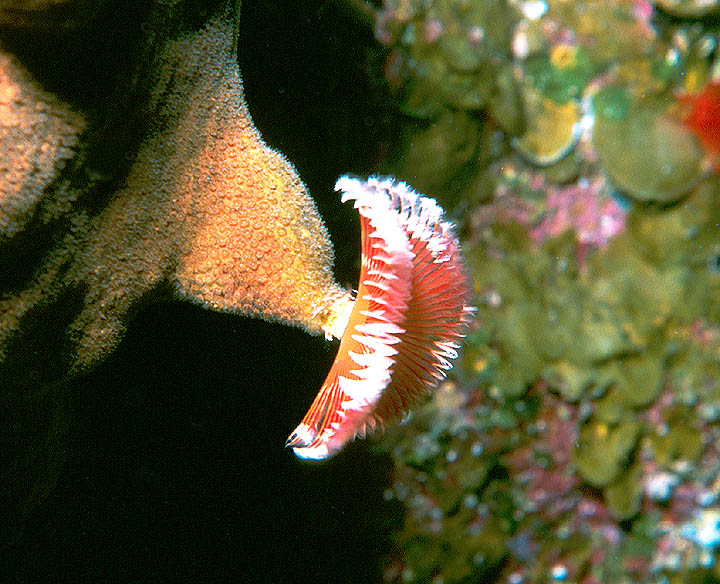
Volume 4 Number 11
Split-Crown Feather Duster Worm on Outer Reef
at San Salvador, The Bahamas


Volume 4 Number 11
Split-Crown Feather Duster Worm on Outer Reef
at San Salvador, The Bahamas

This animal is a Split-Crown Feather Duster Worm. This worm is called a Split-Crown Feather Duster Worm because the circle of antennae called radioles on the top of its head appears to be split into two halves, like a part in your hair. These feathery-headed worms have long and beautiful radioles that reach out up to 2 inches from their tubes. These radioles serve two purposes: catching food from the water like a fisherman's net, and also serving as gills that allow the worm to breathe. If danger threatens, this worm can pull its head and radioles down into its tube for protection. It can disappear in the blink of an eye.
This beautiful red-and-white Split-Crown Featherduster Worm shows how these worms live in tubes. The worm builds a tube and then lives inside the tube. The tube is sort of like the skeleton of the corals. It builds the tube on the surface of a coral, and then the coral colony continues to grow. After a few years, the tube will be buried within the skeleton of the coral, as the coral will have grown around it. All the worm has to do is to keep making its tube longer at the same rate the corals grow, and then it will be protecting not only by its tube of armor but by the strong skeleton of the coral as well. I believe this reddish-brown coral is a Ten-Ray Star Coral. We found it growing underneath an overhang near the top of the wall overlooking Exuma Sound. Also notice the bright green Fan-Leaf Algae in the background.
These animals are living on the outside of the barrier wall of San Salvador's reefs. About 1/4 of a mile from shore on the west coast of San Salvador is a steep cliff at the top of a dropoff that plunges down to the abyss of the Exuma Sound. At the top of this wall is a tall coral reef, extending up from the top of this cliff for as much as 20 to 30 feet. This coral reef is a barrier, creating a lagoon with a shallow sandy bottom between the edge of the cliff and the west coast of the island. Because corals depend on ocean currents to bring them food, there are not as many corals living on the inside of this wall as there are on the outside. The outside of the coral wall looks out over the cliff, and there is a steady flow of food carried in the currents flowing through the abyss. The outside of the wall is covered by corals. But the wall blocks the currents, preventing food from getting to the corals on the inside of the wall, so there are not as many corals on the inside of the wall as on the outside.
Compare this Split-Crown Feather Duster Worm with the Christmas-Tree Worm on the ReefNews website at http://www.reefnews.com/reefnews/photos/christr1.html
--------------------
e-ReefNews and embedded illustrations are
Copyright © 2003, ReefNews, Inc.
ReefNews ® is a registered trademark of ReefNews, Inc.